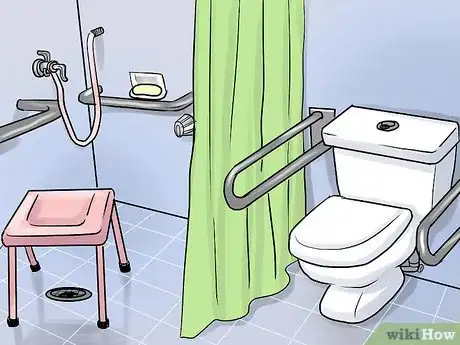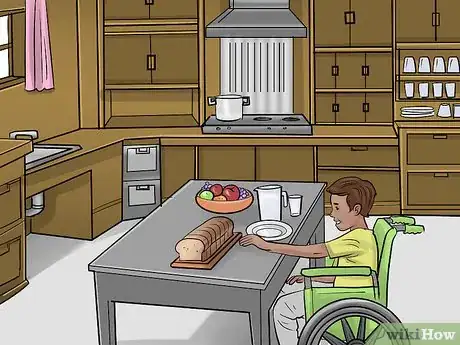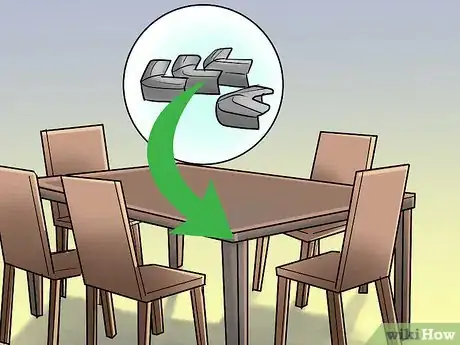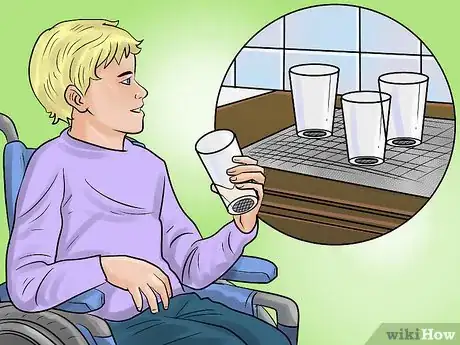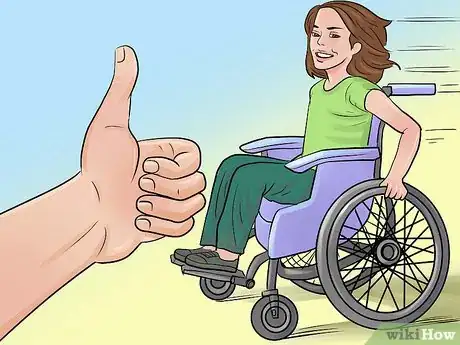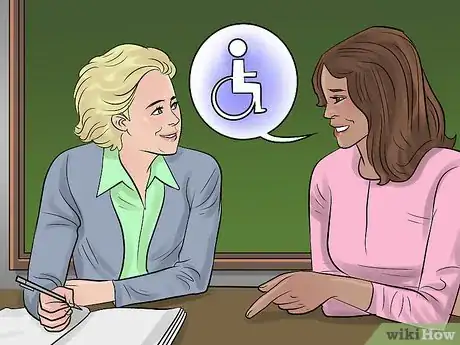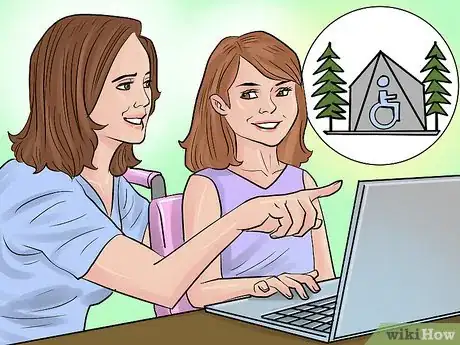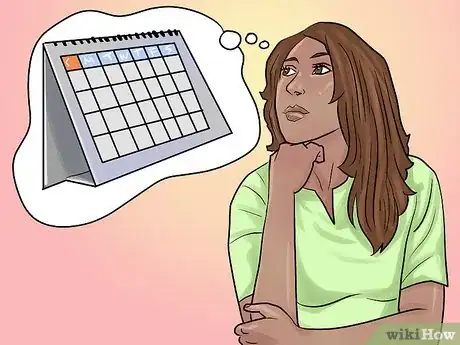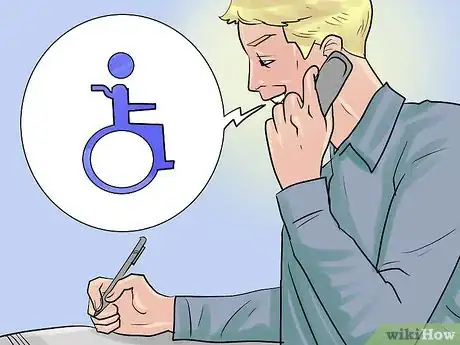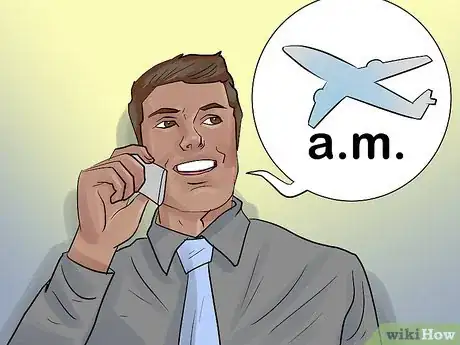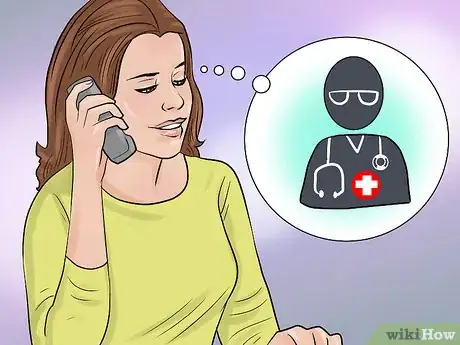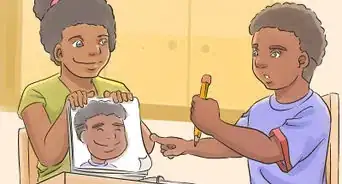This article was co-authored by Paul Chernyak, LPC and by wikiHow staff writer, Jennifer Mueller, JD. Paul Chernyak is a Licensed Professional Counselor in Chicago. He graduated from the American School of Professional Psychology in 2011.
This article has been viewed 23,263 times.
Children in wheelchairs are still children, with the same wonder and interests as others. Unfortunately, they may be left out of events and activities in which able-bodied children participate. If you are the parent, caretaker, or teacher of a child in a wheelchair, you have the responsibility to ensure that the child is adequately included in all activities and is able to move around and explore the world just as able-bodied children can. Helping a child in a wheelchair thrive requires making modifications to the child's home environment and planning travel and activities so they are inclusive.
Steps
Modifying Your Home
-
1Install a wheelchair ramp. If any of the doors into your house require stairs, you need to make that entrance accessible. Even if there is another accessible entrance, making all entrances accessible maximizes the child's safety and gives them the same choices as able-bodied people.[1]
- If a turn is required, make sure it's at least five feet (1.5 meters) square to allow room for the chair.
- The ramp or path should be built far enough out to have a gentle slope up to the door.
- Provide handrails on either side so the ramp is easier for the child to navigate, and make sure the entire area is well lit. You might consider setting lights on motion sensors so the child has a well-lit path without anyone needing to go ahead to turn on the lights for them.
-
2Provide stability and space in the bathroom. Modifying a bathroom can be one of the more expensive projects to make your home safe and navigable for a child in a wheelchair, but these modifications are essential to enable the child to be independent.[2]
- Install a roll-in or walk-in shower so the child does not need help climbing in and out of a tub. This will be especially important as the child gets older and develops a stronger sense of personal privacy.
- Make sure your shower or tub includes a bench where the child can sit that is safe and doesn't get slick with soap and water.
- Bars near the shower or tub and on either side of the toilet can help the child transition in and out of their chair.
- You may have to move the water knobs and shower controls so that the child can easily reach them.
- Provide enough room around the toilet so the child can use the toilet without assistance. There should be enough space for the child to turn the wheelchair around, including a 48- by 56-inch (122- by 142-centimeter) space in front of the toilet and at least 18 inches (46 centimeters) between the toilet and any side wall.
Advertisement -
3Include wheelchair-friendly features in your kitchen. Even though young children probably won't be cooking, you can include modifications in the kitchen that enable the child to get their own snacks and participate in creating family meals.[3]
- Providing adjustable counters that can pull out for the child, or creating at least one wheelchair-height counter, will allow the child to participate in food preparation and other kitchen activities. This helps the child be more independent by enabling you to teach them how to prepare and cook healthy meals.
- Arrange the kitchen so there is enough room for the child to turn around and freely navigate the space, even when appliances are open.
- You may need to lower cabinet handles or drawers so the child can more easily reach them.
-
4Remove or tape down rugs and wires. A child in a wheelchair should be able to move around their home independently. Make sure pathways are clear, and there's nothing that the child could trip over or that could impede the wheelchair.
- In most cases, you should avoid area rugs. While an adult in a wheelchair may be capable of rolling over the edge of a rug, a child may not have the strength or control necessary to do this.
- Install hard flooring or use low-pile carpeting so the chair can move smoothly from room to room.
- Secure wires along the baseboards and run them around the wall, rather than leaving them across the floor.
-
5Ensure open access to all parts of the house. When arranging furniture, there should be enough room for the child in a wheelchair to move freely about the rooms – and from one room to another – without needing any assistance.[4]
- Creating a full circle of space around each room may be the easiest option. This way the child can get to every part of the room.
- If your home has two stories, the child's bedroom should be on the main floor. You may want to consider installing an elevator, although this is an expensive modification.
- There should be at least 32 inches (81 centimeters) of clearance in doorways, and 42 inches (107 centimeters) of clearance in hallways.
- Make sure all interior doors are accessible so the child can open and close them without assistance. You may have to lower door knobs so they are within reach.
-
6Stabilize furniture and equipment. Choose heavy furniture that is relatively stable and can't be pulled over or moved if the child bumps into it or pulls on it. If you have lighter pieces that could potentially be a hazard, secure them to the wall or the floor.
- Avoid tables and furniture with sharp corners, or get corner protectors to cover them.
- Tall shelves and other top-heavy pieces of furniture should be anchored to the wall so the child in a wheelchair can't topple them over.
- Secure televisions, computers, and electronics to the table or shelf on which they sit so the child won't accidentally knock them down. This also gives the child the chance to use electronic devices independently.
-
7Secure loose objects. Loose objects, such as curios on shelves, can be hazardous to a child in a wheelchair. In addition to the hazard, you want the child to be able to manipulate and control objects independently, without having to ask for help.
- Avoid placing unsecured objects near the edge of tables or shelves where they could be easily knocked off.
- You can use velcro for the child's toys and other items so they can more easily control them and put them back in their proper place when done.
- Velcro or magnets also work for dinnerware and glasses, so the plate or bowl stays in place and the child can eat and drink independently.
- You can find inexpensive rolls of adhesive velcro or magnet strips at most discount stores, or at crafting stores.
- If you have cabinets or shelving units for the child, make sure the drawers are secured so the child can open and close them without pulling them out.
Adapting Activities
-
1Advocate for inclusion. Children in wheelchairs often are segregated from other children, or may be singled out when they would rather just be treated like all the other children. As the parent or caretaker of a child in a wheelchair, it's part of your responsibility to stick up for them and their needs.
- Explain that just because the child may not be able to do things the same way able-bodied children can, that doesn't mean the child is incapable of doing those things alongside those children.
- For example, you might say "Olivia would like to play in the sand with the other children rather than having a separate sand table. Do you think you could move them together so she could talk and play with them?"
- Since every child in a wheelchair is different, and has different needs and abilities, a program that worked for one child may not work for this one. Both in education and in extra-curricular activities, encourage an individualized approach that takes the specific child into consideration.
- Be ready to correct people who approach the child based on stereotypes or misunderstandings they have about disabled children. Insist that the child be included in the same kinds of activities that able-bodied children enjoy, rather than being segregated into events exclusively for children with "special needs." It is important to make your child feel as though they can do anything that an able-bodied child can do. This attitude will be invaluable to them as they go through life.
- For example, suppose you're with a child in a wheelchair at a swimming class, and one of the instructors tells you that there's a different class with only handicapped children that she should take instead. You can say "I appreciate your concern, but there's no reason Bobby can't participate in the regular class. He only needs help getting in and out of the pool, and I'm here for that."
-
2Allow the child to choose. Where possible, give the child choices when it comes to engaging in activities or pursuing interests, rather than simply taking them somewhere or giving them something to do. You can help a child in a wheelchair thrive by giving them some measure of control over their life.[5]
- For example, you may give the child choices of three different toys to play with inside in the afternoon.
- You also may want to give the child a choice of after-school activities. Give them a chance to explore their own interests by asking them questions and finding activities locally that they can do.
- There are many non-profit organizations that provide grants and other financial assistance to children in wheelchairs who want to pursue particular activities, such as swimming or horseback riding, that might be too expensive otherwise. Check your local community center or public library to find resources, or do an internet search. You can also look into the Wheelchair Sports Federation to find out about different kinds of wheelchair sports that your child could get involved in.[6]
-
3Encourage the child to do things for themselves. Often, when people see a child in a wheelchair, they want to help by doing things for them. A child in a wheelchair is perfectly capable of participating in activities in their own way and at their own pace.
- This also means teaching other children that they should let the child do things on their own rather than giving them too much help. People often assume that people in wheelchairs need help when they don’t and are not sure how much help to offer. Teach the child to ask for help when they need it, and tell others not to help unless the child in a wheelchair specifically asks. It will be very useful for your child to know how to ask for help when they need it and how to let others know when they don’t need help.
- For example, if you hear another child offering to do something for the child in a wheelchair, you might say "Did Olivia ask you for help?" If the child says no, you can say "I appreciate that you want to help, but you have to let Olivia try to do it on her own. She knows now that she can ask you for help if she needs it."
- Encourage the child to do as much as they can, recognizing that sometimes partial participation is appropriate. For example, the child may not be able to dress herself completely, but can hold her arms over her head and then pull the shirt or sweater down.
-
4Help make schools and classrooms more accessible. A child in a wheelchair will thrive in an educational environment where they can move around with the same ease as able-bodied children. Since you understand the child's needs, you are well-positioned to work with the child's teacher, or with school administrators, to ensure the child gets the most they can out of every learning experience.
- Keep in close contact with the child's teachers, and let them know that if they have any questions or concerns they should talk to you directly.
- Arrange to tour the classroom and other facilities the child will use during the school year so you can make suggestions for enhanced accessibility.
- For example, you might recommend the teacher make the aisles between all the desks wider, not just the aisle next to the handicapped desk, so the child in a wheelchair can move to other parts of the room and work with other students.
-
5Provide tools and adaptive materials. Depending on the child's specific disability and motor-skills development, the child may need special tools so they can participate in an activity designed for able-bodied children.
- For example, if the child has difficulty gripping things, you might want to put tape around crayons and markers so they are easier for the child to grasp and hold.
- Even if the child has limited motor skills, you still want to make sure the things you provide for the child are age appropriate. For example, a child who has difficulty gripping crayons or markers shouldn't be given baby crayons. Rather, you adapt the regular crayons so that child can use them.
- You might want to install edges on tables where the child is working or playing, or use a lid or a cookie sheet to keep loose items contained so they don't get scattered out of the child's reach.
- If you're unsure how to adapt a particular activity, ask the child. Older children typically are able to help you brainstorm ideas that would enable them to participate.
Exploring New Places
-
1Find accessible vacation spots. National laws in many countries, including the United States and Canada, require places of "public accommodation" (such as hotels and amusement parks) to be accessible to people in wheelchairs. However, some are more accessible than others.
- For example, if you enjoy skiing, there are many ski resorts in Colorado that have staff trained to provide adaptive, one-on-one skiing lessons for children with disabilities.
- Many hotels have staff specifically trained to assist families traveling with children in wheelchairs, and may have activities in which the child can participate.
- Resorts and vacation destinations with a focus on exploring and interacting with nature and the outdoors often have specific programs for children in wheelchairs.
- Conduct research online or talk to other families with children in wheelchairs to learn about the best vacation spots that will allow the child to fully participate in activities.
-
2Plan excursions in advance. Children in wheelchairs can enjoy many of the same activities as able-bodied children, such as trick-or treating at Halloween. However, you typically have to do a little work in advance to make sure the child is able to fully participate.[7]
- For example, if you want to take a child in a wheelchair trick-or-treating, you'll need to scout out a route in advance to make sure all the houses are accessible for that child. If you can't find an appropriately acceptable neighborhood, you may want to find alternative solutions, such as trick-or-treating at a shopping mall or participating in a local "trunk or treat" event that takes place in a parking lot.
- Let the child take part in the planning so they're prepared for the event and know what to expect. Count on the child to let you know what you can do to help make the event more accessible and enjoyable for them.
- Make sure you get the child's input to the extent appropriate before buying non-refundable tickets or otherwise committing to a particular event – especially if you are doing it solely for the child's benefit. It is important to include them in the decision-making process. Give them the power to choose what they want to do rather than forcing them to do something in which they're not interested.
-
3Make arrangements when booking your trip. Making reservations online may not be an option if you are traveling with a child in a wheelchair. You need to talk to someone and explain the need for accommodations in advance so there won't be any unpleasant surprises.
- If you're flying to your destination, speak with someone on airline staff when you book the flight so you can explain the accommodations the child will need.
- Try to arrive at the airport an hour earlier than you normally would, so you have time to go through security and get to your seats. Remember that airlines allow disabled passengers to board first.
- If you're staying in a hotel at your destination, talk to hotel staff before you arrive rather than booking a room online. This way you can get direct confirmation that the room will be accessible for the child and have any specific requirements covered.
-
4Schedule flights in the morning. Earlier flights are more likely to be on schedule than flights in the afternoon, and children tend to be better travelers in the morning when they have more energy and haven't already been exhausted by a full day.[8]
- If at all possible, try to book direct flights. If you must have a layover, make sure airline staff understands that the child will need their wheelchair during the layover – otherwise, it may be checked all the way through to your destination.
- Study airport layouts in advance so you'll be able to easily find your gates and navigate to baggage claim. You'll also want to know where snacks and drinks can be purchased once you go through security, in case the child needs anything on the plane.
-
5Connect with a doctor at your destination. If you're traveling with a child in a wheelchair who has continuing medical needs, talk to the child's pediatrician to identify a doctor or specialist you can work with at your vacation destination in the event of an emergency.[9]
- If you can get a recommendation from the child's regular pediatrician, you can talk to the doctor before travel so you can get to know them and they can learn more about the child's condition.
- Carry the child's basic medical records with you when you travel, as well as a brief summary of the child's medical history.
- Keep names, email addresses, and telephone numbers of all the child's healthcare providers handy in the event you need to get in touch with them quickly while you're out of town. It is also a good idea to keep a record of the places your child regular visits. Also, talk with your child about what to do and who to contact in case of an emergency.
References
- ↑ http://www.homecity.com/creating-a-home-where-your-child-can-thrive-with-a-disability
- ↑ http://www.homecity.com/creating-a-home-where-your-child-can-thrive-with-a-disability
- ↑ http://www.homecity.com/creating-a-home-where-your-child-can-thrive-with-a-disability
- ↑ http://www.homecity.com/creating-a-home-where-your-child-can-thrive-with-a-disability
- ↑ https://www.utoledo.edu/education/grants/direct/pdf/Module%204/R%20AdaptingActivitiesand%20materials.pdf
- ↑ http://www.wheelchairsportsfederation.org/
- ↑ http://wsrsolutions.com/wheelchair-users-guide-to-trick-or-treating/
- ↑ http://www.friendshipcircle.org/blog/2012/01/09/a-special-needs-pre-flight-checklist/
- ↑ http://www.friendshipcircle.org/blog/2012/01/09/a-special-needs-pre-flight-checklist/

